Newsletters
Latest edition
July 2021
-
A three-gigawatt renewable hydrogen facility in Central Queensland is one step closer with land secured for large-scale production in Aldoga, west of Gladstone.
Publicly-owned generator Stanwell is partnering with Japanese industrial heavyweight Iwatani Corporation to develop the export-scale facility, creating more than 5000 jobs for regional Queenslanders.
The Stanwell-Iwatani project will be a key driver in Central Queensland’s hydrogen supply chain and the significant manufacturing and investment potential it will unlock.
The project could generate $4.2 billion in hydrogen exports and $10 billion for the Queensland economy.
Stanwell signed an option agreement with EDQ locking in land for the facility, which is a step towards the proposed project becoming a reality.
The 236-hectare site at Aldoga was identified as the preferred location due to its size and proximity to port, power and pipeline infrastructure.
EDQ has 9700 hectares strategically located land in the Gladstone State Development Area, to support industry growth and job creation.

-
The $5.95 million permanent accommodation precinct, adjacent to the new $70 million Roma Hospital, opened in June.
The precinct was built by Woollam Constructions and supported 81 jobs, drawing on seven local construction-related businesses and delivered over 4300 training hours to 13 apprentices.
Located in EDQ’s Clearview Rise estate, the precinct was funded under the State Government’s Growth Area and Regional Infrastructure Investment Fund.
The days of students living in demountable units in the hospital grounds, or in motels and other short-stay accommodation are over.
The new precinct offers a genuine home away from home for students working and learning at the hospital during their hospital regional placement.
The landmark project sets a new benchmark in regional student accommodation standards across Queensland, and will provide residents, many of whom have never lived away from home, with a meaningful sense of belonging.

It features 20 bedrooms in modern residential pavilions with communal facilities and recreation areas.
It also has solar power, LED lighting, rainwater tanks and sustainably harvested Australian hardwood timber decking from the Cape York Timber company, an indigenous-owned business operating on indigenous properties creating employment and training.
The precinct will help South West Hospital and Health Service attract and retain staff in the region.
This means better health services for the greater Roma community and sustained employment outcomes for many years to come.

-
Construction of 1.5 kilometres of sub arterial road, bridge and cycleway along Binnies Road West in the Ripley Valley Priority Development Area was completed in April.
Built by Orchard Property Group and funded under a $7.14 million state government catalyst infrastructure agreement, delivery of the vital infrastructure supported more than 40 jobs.
The $8.7 million Binnies Road West will play an important role in the population and community growth throughout Ipswich’s southern corridor. It will provide Queenslanders with access to an additional 3300 affordable residential lots.
Servicing the north west precinct of the PDA, Binnies Road West will eventually connect several landholdings including Aurora, Cadence Estate, Ripley Valley Estate and Monterea Estate.
In the future, it will also connect residents to schools, retail, recreation facilities and employment hubs throughout the area.
Binnies Road West is not yet open to the general public. It will remain restricted to construction vehicles only working on adjoining estates and Cumner Road until late 2021.

-
Construction of a new wastewater management plant to service a priority growth area in Southern Redland Bay is the latest project to receive loan funding from the Building Acceleration Fund.
The State Government’s investment of $15 million in essential catalyst infrastructure is set to unlock over 5000 lots, improving land supply and housing affordability.
Co-investing with Lendlease in the stage delivery of a $30 million wastewater treatment plant will allow for the construction of:
- up to 3000 residential lots
- town centre
- potential primary school
- community and sports facilities.
The plant will service the broader Southern Redland Bay area as well as Lendlease’s master planned community ‘Shoreline’.
The infrastructure funding will also unlock a further 2000 lots outside Shoreline.
Stage 1 works are expected to start late 2021. Redland City Council will operate and maintain the wastewater treatment plant.
Read more about the project Infrastructure funding to unlock land supply in SEQ - Ministerial Media Statements

-
Construction on the first 53 terrace homes at Carseldine Village, a 100% solar and battery neighbourhood, is underway, supporting around 60 construction jobs.
Carseldine Village is one of the first residential developments in Queensland to commit to delivering net zero energy emission terrace homes with energy saving features to slash power bills.
It will be a 100% solar and battery neighbourhood, saving homebuyers thousands of dollars in electricity.
All the Carseldine Village terrace homes will come with solar PV, battery storage systems, heat pump hot water systems, WiFi air conditioning and will be electric vehicle charger ready, saving home owners up to $1600 per year on their power bills.
Aldridge and Miranda Joseph were the first buyers to sign a contract with builders Vantage Homes Qld to live in Carseldine Village.
“We are delighted to see our new home start to take shape,” Mr Joseph said.
“It’s one thing to see the house and land on paper, but another to be able to see it being built.
“Our daughter bought a home in Fitzgibbon Chase, a previous Economic Development Queensland project, so Carseldine Village sparked our interest.
“When we heard about the green credentials of the terrace homes, being a 100 per cent solar PV and battery storage and saving up to $1600 annually on electricity bills, we knew this was where we wanted to live.”

-
A two-year home energy management system (HEMS) pilot at Carseldine Village could change the way energy is managed by residents and power companies in the future, saving money and making energy use more efficient.
The pilot project is a collaboration between Evergen, EDQ, Energy Queensland and twenty-five homeowners at Carseldine Village, a new net zero energy emission terrace home residential development.
EDQ’s Project Manager, Brooke Walters said she was pleased the two-year home energy management study was being undertaken as it will build on the 100% solar and battery innovations included in the Carseldine Village terrace homes.
“This comprehensive study will help us to better understand energy use and management in homes, enabling better future design of homes and planning of the electricity grid to enable greater levels of renewable energy to be generated and used,” Ms Walters said.
Evergen CEO Mr Hutt said he is excited that Evergen’s intelligent control software system was selected by EDQ for the pilot project.
“The objective is to learn how home energy use can be modified throughout the day to provide the best value to the homeowner and avoid congestion on the grid,” Mr Hutt said.
“Capturing and using energy in the smartest way possible should see anyone with solar and battery systems receive free energy, for life.”
The HEMS pilot will coordinate, through Evergen’s intelligent control software, the home’s rooftop solar, battery, and air conditioning units based on the homeowner preferences and the needs of the network.
The software system, through data gathering, will learn the homeowner’s lifestyle patterns and manage decisions about storing energy in the battery or putting excess energy back to the grid.
The HEMS pilot could lead to wider benefits for the entire neighbourhood as it helps manage energy flow across the local network, assisting to strengthen the electricity grid to respond to higher temperatures and heatwaves predicted for the future.
The pilot project is expected to begin in the next few months.

-
EDQ is exploring the suitability for large scale wind and solar power to attract and support strategic heavy industry at Salisbury Plains in Bowen.
Salisbury Plains, in the Abbot Point State Development Area, is an ideal location for industrial and port-related heavy industry.
John White EDQ A/Executive Director Industrial said “we are looking at combining cost effective and clean energy with a strategic industrial area serviced by an export port – it’s a pretty unique strategic opportunity”.
A SODAR - Sonic Detection And Ranging unit is currently collecting a years’ worth of wind and solar resource data which will provide a good picture of the wind and the solar at the site. Unlocking a combined large-scale wind and solar farm could catalyse a large scale renewable based industrial opportunity for Queensland. Data from the SODAR can be made available upon request.
EDQ is one of the State’s largest industrial land developers. EDQ takes a long-term approach to ensuring strategic industrial land is available as Queensland continues to grow with around 20,000 hectares of industrial land across the state for future industrial use.

-
Nyanda Cultural tour
Recently, a number of EDQ staff took the opportunity to take part in a Nyanda Cultural Tour – a local indigenous tour through Brisbane’s Nudgee Waterholes, Bora Ring and Bush Food Gardens.
The team learnt about and experienced a bull-roarer at the sacred Bora Ring; a smoke ceremony; seasonal bush food tastings; and weaving and ochre-making demonstrations.
The Aboriginal owned enterprise provides authentic, immersive and interactive educational activities focussing on Aboriginal stories, history and cultural performance elements.
For more information visit, www.nyandaculturaltours.com.au

Jason Camden – Spotlight on PDAs 24 June 2021
In June, the Urban Development Institute of Australia (UDIA) put the spotlight on Priority Development Areas, and EDQ’s General Manager joined the discussion as a panel member. He was joined by CDM Smith’s Principal Economist Marcus Brown, Green Street Homes Director Paul Eagles and Peet Limited’s General Manager Michael Stone.
With 34 PDA’s across Queensland, they represent great opportunity for those associated with, and within the development industry. The event generated a lot of discussion around the current and future roles of PDAs, and the government’s current response to the current land supply issues.

(L-R Anna Cox, Director of Policy, Strategy and Regional Services at UDIA, Paul Eagles, Marcus Brown, Michael Stone, Jason Camden)
Peter Anderson – Green Building Day Brisbane 1 June 2021
EDQ’s Project Director Peter Anderson was invited to present at the Green Building Day Brisbane. He presented on how EDQ is driving innovative initiatives and raising the bar in Queensland. The new, sustainable and innovative Carseldine Village – one of Queensland's first 100% solar and battery terrace home neighbourhoods, recently achieved a 5 Star Green Star Communities rating and has proved very popular with home buyers.

EDQ Development Industry Forum – Friday 11 June 2021
Twice a year, EDQ hosts a Development Industry Forum. The topic of the June event was Renewables: The Merging of Property and the Energy Grid.
Around 80 consultants, planners, developers, architects and energy industry representatives gathered to hear presentations from Carly Irving, Executive General Manager of Yurika, Mark Paterson, Chief Strategy Officer of MD Australia Pacific, Strategen and EDQ’s Director of Innovations Dr Michael Kane.
The forum generated a lot of questions and in-depth discussion afterwards amongst the audience, centred around the future direction of our industry.
If you and/or your colleague would like to register to be invited to our next EDQ Development Industry Forum, the best way is through this link: http://ems.gs/3jme0ksbwEG
-

Matt was born in Cape Town, South Africa and moved to Australia whilst still in school. Matt had always had a passion for building and construction and pursued this by studying a Construction Management degree at QUT. Whilst studying at QUT, Matt completed a cadetship with a construction subcontractor. On completion of his studies, Matt relocated back to the Sunshine Coast where he started working with Vantage. Since beginning as a Contracts Administrator on Vantage’s commercial projects, Matt has been the Project Manager on multiple commercial projects before moving across to the residential team as the General Manager of Vantage Homes.
How do you start your day? I always start my day with a drive along the coast to get a look at the ocean and a coffee at Design Trader by Vantage.
Where do you gain inspiration for your work? I am very luck to work with a talented team at Vantage Homes who are always pushing the boundaries of innovative and stylish built form product. Working through the entire process from initial design concept to handing over the completed home to a happy home owner is very fulfilling. Living on the Sunshine Coast it is easy to draw inspiration from the local surroundings, and we try to incorporate that into all of our projects in coordination with the latest design trends and building products.
What is the most challenging project you have worked on, and why? I would say one of the most challenging projects I have worked on is the Carseldine Village project. Ensuring that the various requirements of Liveable Housing Australia, the energy performance requirements and the innovative solar battery inclusions couldbe achieved whilst offering an affordable product required a great effort from all involved and has resulted in the delivery of a unique product.
Tell us about a place in the world that Queensland could learn from, and why? I think Queensland could learn a lot from Iceland in terms of renewable energy usage. Obviously Iceland’s renewable energy sources are very different to what’s available in Queensland. However the way in which they maximise the use of their renewable energy and ensure minimum wastage and negative by-product from the process, I am sure there are some good lessons there.
What is your prediction for Queensland in the next 50 years? With the continual growth forecast for Queensland, I predict we will see major changes across our streetscapes. I think we will continue to see a shift towards small lot housing and terrace home product incorporating renewable energy. The low maintenance lifestyle of terrace living is becoming increasingly popular.
March 2021
-
Work on Archerfield Airport Corporation’s $17.8 million runway and other infrastructure upgrades are well underway thanks to the state government’s $13.8 million co-investment under the Building Acceleration Fund.
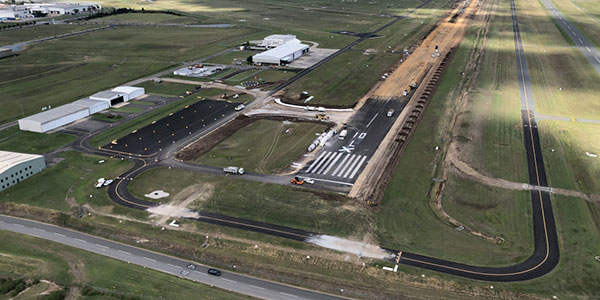
The essential airside infrastructure improvements including pavement works, installation of services, new ground lighting facilities and visual aids will enable growth in next-generation aircraft movements in and out of the airport.
Stage 1 works began in October 2020 on the refurbishment of the runway. It is estimated the adoption of innovative recycling practices onsite, reduced the number of truck movements by approximately 6000. Head contractor BMD expects the runway will be open for daytime operations in coming weeks.
Interest in the Building Acceleration Fund initiative was overwhelming with 157 applications with a total value of requested funding of $1.377 billion received from developers, councils and industry across the state.
Other projects which have received Building Acceleration Fund funding include:
- $15 million towards infrastructure for the next phase of Yarrabilba, supporting around 100 jobs and unlocking access to over 2,000 affordable residential lots.
- $15 million towards the construction of the Bahrs Scrub Roadworks Project, supporting around 34 construction jobs and potentially a further 60 in supply chains, plus accelerating the development of 1780 dwellings and a retail centre.
- $10.5 million to deliver water supply and sewerage networks and a sewerage pumping station to kickstart the delivery of up to 3,000 new homes in Caboolture West Neighbourhood Development Plan 1, supporting around 100 new jobs.
This strong support from industry in our post-COVID economy means we will have a pipeline of high-quality infrastructure projects that can generate immediate economic benefits, create jobs and unlock future development opportunities.
Further BAF projects will be announced once they are approved for the interest free loans.
-
The extent of work includes the civil construction creating 53 terrace housing lots and an aged care site as well as upgrades to three external intersections, including two on Beams Road and one at the corner of Dorville and Zillmere Roads. The aerial photo (beside/below) of Carseldine Village illustrates streets and laneways beginning to take shape.
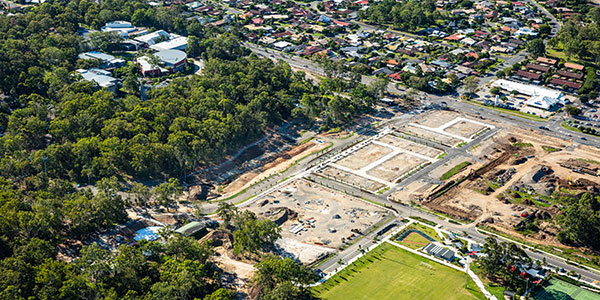
Stage 2 construction is now also underway to create a further 48 terrace lots and two development sites.
This project has been accelerated to assist in the state’s economic recovery and has not experienced any construction delays during COVID-19 restrictions.
A total of 92 lots in Stages 1 A&B and Stages 2 A&B have been released to market and are now sold out.
The news that Carseldine Village terrace homes will be delivered with 100% solar and battery (see other newsletter story/insert link) led to a large lift in enquiry, demonstrating a real buyer-interest in this type of product.
A further key milestone for Carseldine Village is the beginning of construction of the first terrace homes, which commenced this month.
-
The Queensland Government’s Regional Home Building boost and the Federal Government’s HomeBuilder grant have supported a resurgence of interest and activity in regional Queensland living.
EDQ has seven regional residential estates throughout Queensland, including The Village in Townsville, Woodlands in Mackay and Hillclose and Tannum Sands in Gladstone.
In the 2019/2020 financial year, EDQ sold 37 regional home lots and generated around $9.25 million in construction economic stimulus activity.
However so far this financial year, those figures have almost tripled to 118 home lots sold, generating around $29.5 million in construction economic stimulus activity.
Similar trends have been seen elsewhere around Australia as Covid-19 led to many people reevaluating their lifestyle.
This, together with the grants on offer, has led to the increased sales activity throughout regional Queensland.
-
In June 2019 the state government announced plans to invest $5.95 million for the construction of a student accommodation precinct near the new $70 million Roma Hospital.
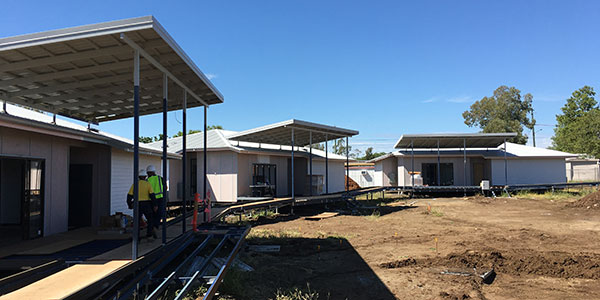
Offering the first purpose-built student accommodation off hospital grounds, the precinct will go a long way to assisting the South West Hospital and Health Service attract and retain the best possible staff to the region.
Located within walking distance of the hospital, the accommodation will create a sense of community for health students, many of whom would be living away from home for the first time.
In 2020, Woollam Constructions, one of Australia’s oldest building companies, was awarded the contract and started work straight away on the high-quality accommodation.
Fast forward to 2021 and construction is nearly complete. Pavilions are in place and the internal fitout is coming along quickly with most joinery now installed.
Built in Economic Development Queensland’s Clearview Rise residential estate, the precinct features 20 bedrooms in modern residential pavilions, multiple communal facilities and recreation areas, and a pool.
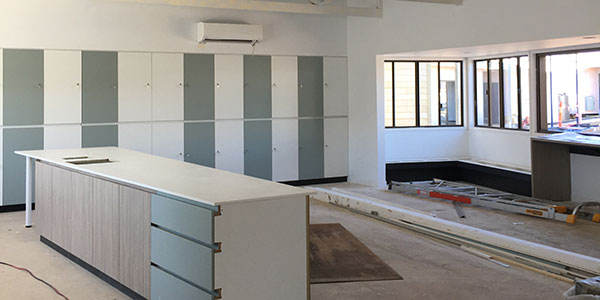
This project will set a new standard in regional student accommodation in Queensland and we look forward to welcoming the first intake of residents in mid-2021.
-
Innovative, industry-leading developments in Carseldine and Oxley featuring 100% solar and battery neighbourhoods are progressing.
Dr Michael Kane, EDQ’s Director of Innovation said the net zero energy emission homes showcase innovation and sustainability while saving home buyers thousands of dollars on electricity bills.
“A lot of work went on behind the scenes with Energex to make sure we had the right infrastructure in place to support the technology on these developments. Now that it has been implemented successfully at Carseldine, it can be replicated at other master-planned communities,” Dr Kane said.
The Carseldine Village terrace homes and the Oxley Songbird detached residential dwellings homes will come with solar PV panels, battery storage systems, heat pump hot water systems, WiFi air conditioning and will be electric vehicle charger ready.
“Both developments have been an outstanding success with home buyers, with most stock being snapped us as soon as it is released,” he said.
“This demonstrates there is a real appetite within the market for housing product with these types of innovations.”
An energy assessment found in comparing an average existing home to a similar sized energy efficient terrace home with solar PV and an AlphaESS battery system at Carseldine Village, owners could save up to $1600 per year.
At Oxley’s Songbird housing development, a landmark deal with Natural Solar and Tesla will see homeowners have access to a solar PV and Tesla Powerwall package.
“Solar PV panels combined with a Tesla Powerwall will have on and off grid capability and the option to link into a virtual power plant to generate revenue for the homebuyer,” Dr Kane explained, saying this takes the technology a step further into the future.
“This means that in the event of a Queensland storm or power-outage in Oxley, these homes will still have power to key circuits, meaning lights, fridge, and the internet will still be working without disruption.
Natural Solar CEO Chris Williams said the innovation signifies the Queensland Government’s support of clean, green energy.
“Homeowners at Songbird Oxley, can expect to save up to $2000 per year, delivering a return on investment in around 5 years. With solar, you typically generate more energy than you need, so by combining with the Tesla Powerwall, it can be stored and used when needed,” he said.
"As Australia's largest installer of solar batteries, we are proud to be at the forefront of energy innovation within new homes.
“Helping deliver this collaboration between Tesla and the Queensland Government closely aligns with our vision that all new homes across Australia should include world class leading energy efficiency on the journey to net zero carbon emissions.”
For more information visit Carseldine Village or Songbird, Oxley.
-
A digital challenge has been set for QUT students, providing them with real life industry experience at EDQ’s Northshore urban renewal precinct.
For the third year in a row, EDQ has partnered with students from the QUT Information Technology Capstone Program, to provide them with real workplace challenges and insights.
In 2020, the program focused on car parking with onsite car parking at Northshore being highly sought after during peak events.
Brooke Walters Senior Project Manager in EDQ’s Innovation Team said the students were tasked with finding a smart digital solution to communicate parking availability to visitors on their arrival to the precinct.
“The goal was to create a more efficient and safer parking experience,” Ms Walters said.
The student investigations led to an Australian first testing of sensor technology, the PNI Place Pod. This technology provides a very cost effective and efficient solution in counting cars entering and leaving the carpark and is able to transmit the data via the Northshore Internet of Things (IoT) gateway to a dashboard and signage boards. This provides visitors with real time parking availability.
“The beauty of the technology, is that it requires no costly modifications to the carpark and only needs sensors at the entrance and exit of each car park rather than a sensor in every bay,” she said.
Initial testing/trials conducted by QUT students proved it performs well and EDQ are now conducting further work around this technology.
This year, QUT students have been given the challenge of using water more sustainably across the Northshore precinct for irrigation. Stay tuned for their solution!
-
At the UDIA Queensland Logan Housing Strategy, EDQ’s General Manager Jason Camden presented on growth management in the region. The Logan region has the potential to grow by an additional 70,000+ homes over the next 50 years – that’s the size of Townsville! And that growth is forecast in EDQ’s Priority Development Area’s alone. With a $1.2 billion Infrastructure Agreement in place with Council and major developers, this growth is sustainably planned.
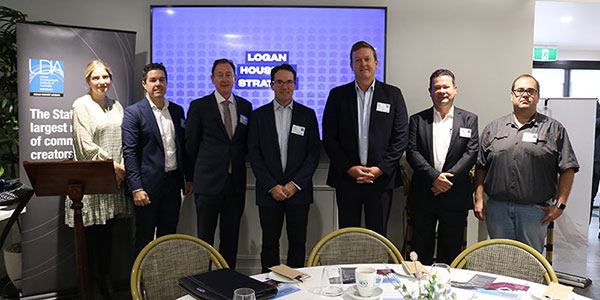
EDQ’s Executive Director Lavinia Dack recently presented at the NAWIC QLD - National Association of Women in Construction's International Women’s Day Breakfast on 8 March 2021, on this year's theme of #choosetochallenge.
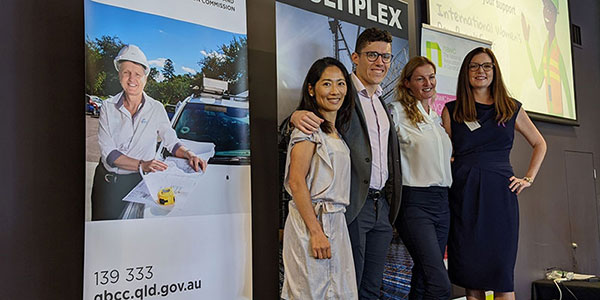
The 2021 BiiG Network Innovation Reset Public Sector Conference in Brisbane on Wednesday 17th February featured a panel discussion with EDQ’s Dr Michael Kane presenting on the Myths and realities of public purpose partnerships – looking at the 100% solar and battery neighbourhoods in Carseldine and Oxley.
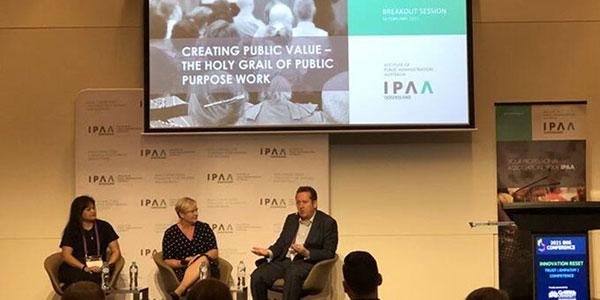
-
Campbell was born and raised in the small country town of Goondiwindi on the border of QLD and NSW in a family of seven. Growing up he always had an interest in construction working for a Builder throughout high school and then for a construction company after school where he was able to get some hands on experience in the civil world building roads and operating machinery. From this he knew what career path he wanted to follow so he furthered his studies at QUT enrolling in civil engineering and then went onto to score his first Graduate Role at Shadforth. Two years later he was able to start managing his own projects and now he has multiple projects across the Brisbane and Ipswich regions ranging from new road infrastructure to industrial and residential subdivisions.
How do you start your day? I start the morning early with a coffee at 5:30am to kick start the day on my way to site for the daily prestart. Listening to music on the drive is a great way to get myself in the mood for the day. Prestart is generally followed with a run through with the project team on the days activities and a drive around the site before starting to tackle the long list of emails and phone calls.
Where do you obtain inspiration for your work? I love seeing a projects progress from start to finish, from an empty paddock to fully built subdivision or road. Throughout a projects life when the multiple aspects start flowing together to create something from nothing is really satisfying to witness.
What is the most challenging project you have worked on, and why? In construction every project is challenging, no matter how well you plan there will always be obstacles to overcome, whether it is inclement weather, intense community engagement or unforeseen design issues that need to be resolved on the go.
Tell us about a place in the world Queensland could learn from, and why? I feel Queensland has a lot to learn in the way of public transport compared to most of the world. Most countries in Europe have excellent public transport systems that you can easily navigate and access and is cost effective. Not to mention the benefits for the environment.
What is your prediction for Queensland in the next 50 years? With the current growth we are seeing in the urban sector its hard to imagine where we will be in 50 years, as prime developmental land starts to become more rare it will be interesting to see where people will want to live next.
Last updated: 23 Sep 2021
